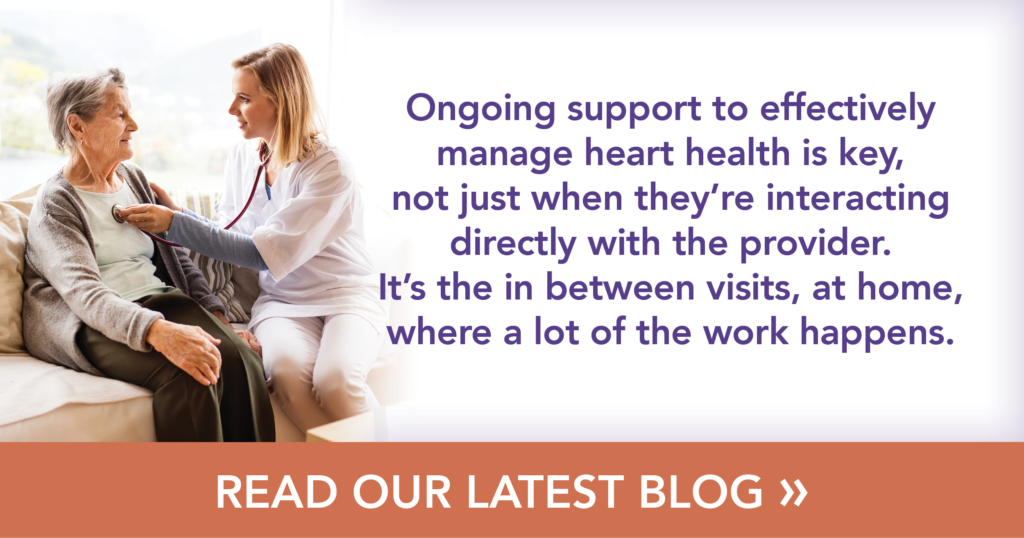
Central to Lifespark’s mission to help people age magnificently is helping them stay healthy at home. For individuals with heart failure, the stakes are particularly high. According to the National Institutes of Health, heart failure in the United States accounts for roughly 700,000 inpatient admissions and is a leading cause of morbidity and mortality. It’s also an economic burden, with inpatient costs estimated at $18 billion annually.
Partnering for heart health
“Preventing a heart failure exacerbation is most successful when we as providers take the time to create a partnership with the client and the client’s circle of support,” said Jonathan Weiner, MD, Lifespark Medical Director, Value-Based Initiatives. “The partnership ensures that individuals have ongoing support to effectively manage their heart health, not just when they’re interacting directly with the provider, but also in between visits, which is where a lot of the work happens.”
The work, as Dr. Weiner explained, is shaped by the plan which the provider and client develop together, with input from the client’s support system, to promote heart health and a good quality of life. “That process does take time because it involves asking a lot of questions about the client’s home environment, day-to-day life, activities, food they eat, and the people they can count on if they need help,” he said.
Another important part of the process is education. “If we’re recommending dietary changes, like eating less salt, we can’t assume that the client knows how to do that,” he said. “We need to give them the tools and information to help them be successful.”
One of the advantages of in-home primary care is seeing the client’s home environment in person. “We can learn a lot about how they’re living, what barriers they might be facing—if medication is strewn across the counter or food is going bad in the refrigerator—and what we need to do to better support them,” he said.
Finally, providers need to understand what “feeling well” looks like to the client. It could be having the energy to watch a grandchild’s soccer match, being able to walk six blocks, or getting dressed without feeling winded. While keeping track of their weight and vitals gives the client objective data, lifestyle details can help them and their family monitor their heart health in more subjective ways, Dr. Weiner said. “If the client is suddenly having a hard time putting on their shoes, that could be an early warning sign that something is amiss.”
Prevention and contingency planning
Dietary changes, such as reducing significant salt intake, excessive fluid consumption, and alcohol use, can help prevent some of the common symptoms of heart failure, such as shortness of breath and swelling in the legs and ankles. Exercise and physical rehabilitation can also help by strengthening the heart and improving circulation. In addition, Dr. Weiner and his team look to best evidence-based treatments for each type of heart failure to determine which medications are going to help in the short-term and in the long-term.
“Having a plan in place is not about restricting people or telling them what they can and can’t do,” he said, “It’s about avoiding a potential health crisis.” If the client’s family is coming to town and they know they’ll be eating out and eating more salt, the client can work with their provider to adjust the plan.
“However, despite your best efforts, especially with clients who have multiple chronic conditions, there’s going to be an exacerbation of the disease,” he said. “That’s where contingency planning comes into play.”
As soon as the client or a family member notices a change, they know what to do, which could be to call their provider or take additional medications which they already have in their home. “Our goal is to get on top of these symptoms as early as possible to prevent the need for hospitalization,” he said.
Value-based care
Lifespark’s approach to heart failure management isn’t the exclusive domain of in-home care, but within a 15-minute clinic visit, providers just don’t have the time to ask about their client’s day-to-day life, build a partnership with them, and create a plan to support heart health, Dr. Weiner said. “Another issue is that clinic visits are limited to a single point in time and a narrow range of metrics—weight, blood pressure, heart rate—with no way to assess how the client is actually managing at home.”
The problem, he said, is less about the clinic and more about the fee-for-service payment model which rewards health care organizations for the volume of services they provide, independent of the results. In contrast, the value-based care model focuses on health outcomes and reducing unnecessary costs. This approach gives organizations like Lifespark the time and the flexibility to partner with their clients in a way that aligns evidence-based care with the client’s goals.
Looking ahead
Life expectancy for people with heart failure can vary greatly, but wherever the individual is on their life journey, Dr. Weiner and his team make sure that they’re doing everything possible to help their client live as well as they can for as long as they can.
“Towards the end of life, there are a lot of advantages to starting hospice earlier, especially for clients who want to avoid being hospitalized,” he said. “It’s not what everyone chooses, but for those who do, it’s a terrific, and underutilized, Medicare benefit that offers people an extra layer of care and support on their own terms.”
To learn more about Lifespark’s approach to complete senior health, visit Lifespark.com.


